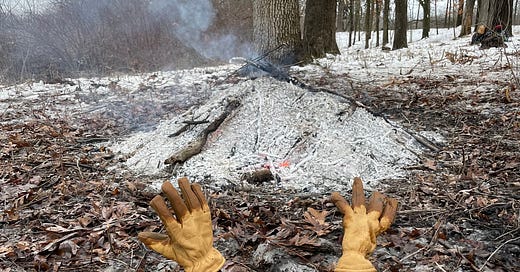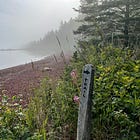I spent the past two days battling buckthorn.
Habitat restoration work often feels like a thankless job since it can take years for the fruits of your labor to become evident. I would much prefer to build a stone staircase or cut tread for a new trail—tasks that have definitive end points and can be completed in a long weekend. But on Friday morning, I gathered with fifty or so other people in a parking lot, all bundled up against the single digit temperatures and unified in our goal of (targeted) destruction.
Common Buckthorn was introduced to North America in the mid-1800s as a dense, resilient, and fast-growing hedge and it did that job a little too well. According to the Illinois Department of Natural Resources, “buckthorn displaces native shrubs and trees in the mid-layer of the woodland where many bird species nest” and “forms an impenetrable layer of vegetation that further degrades wildlife habitat.” In the area where I worked this weekend, buckthorn has shaded out Shooting Stars and other spring ephemerals, crowded into the open spaces of an oak savanna, and encroached on a marsh that is home to salamanders, frogs, muskrat, and a variety of birds, including Wood Ducks, Green Herons, and Virginia Rails.
Restoring the habitat is important work, but that’s not why I braved the cold. I was there because the people gathered in that parking lot have become my community over the past couple years.
I hadn’t even fully stepped out of my car when someone called out my name and told me I needed to meet a woman who had also driven up from Chicago, a first-time volunteer who was looking to get involved now that she had retired. My conversation with her barely wrapped up before I spied a dozen more people to greet—an impressive number considering faces were obscured by thick hats and scarves. Even my short walk across the parking lot to the port-a-potty was interrupted by multiple hugs and hellos. Everywhere I turned, there was someone who I was excited to see and who was excited to see me.
That’s not my everyday experience. Despite my extroversion, I live a fairly solitary life. I may be surrounded by people as I walk through my urban neighborhood, but they are strangers who studiously avoid eye contact on the sidewalk and in the grocery store aisles. At a trailwork project, no one is a stranger.
I started volunteering on the Ice Age Trail at a time when I felt especially disconnected, though I didn’t attend my first event with any expectation of making new friends. It was supposed to be a one-time experience to give back and offset the wear and tear from all the hiking I had done. I signed up for a 4.5 day trailbuilding project in Central Wisconsin in July of 2022—building a boardwalk through a white cedar swamp—and somehow that snowballed into a new hobby.
In retrospect, it’s not a surprise that I got hooked. Trailbuilding projects are like summer camp and I loved camp as a kid.1 As an adult, where else can you and dozens of newfound friends pitch tents in a field and then spend a long weekend working together, eating meals together, and relaxing around the campfire together? People get inexplicable nicknames, crews bond over stubborn rocks, and everyone heads home dirty, sore, and a little sleep-deprived.
A month after that first project, I went to Isle Royale for a solo backpacking trip.2 Though the trails there are sparsely populated during the day, everyone is funneled to established campsites, so you inevitably strike up conversations while filtering water for dinner. I loved having that nightly social outlet and after a particularly great evening, I wrote in my journal, “I think I might want to thru hike the AT? Like, I want a hike with the camaraderie of IR.”3
Luckily, before I pursued that idea any further, I went to my second trailbuilding project. Like returning to camp the next summer, it’s a different experience to show up and see familiar faces in the crowd. By the end of that weekend, I knew I didn’t need a thru hike to find my trail community—I had friends spanning in age from 25 to 75 and I knew exactly where I could find them in the future, just by consulting the trail crew calendar. This past Friday, they were battling buckthorn in the bitter cold, which meant I was too.
So if you, like me, have ever had the thought that maybe walking from Georgia to Maine would be a good idea just to get some regular social interaction in your life, let me offer another suggestion. Find your local (or not so local!) trail and get your hands dirty. After all, it’s a lot easier to reserve a day or two of vacation time to attend a trailbuilding project than it is to put your life on hold for six months to thru hike one of the Triple Crown trails4. You might just find the community you’ve been wishing for and you can take down some buckthorn in the process.
The summer camp I attended for six years in middle and high school was a creative writing camp, not an outdoors camp, but the camaraderie of being in close quarters for an extended period was the same. I still went home sleep-deprived, but probably a bit cleaner than if I’d spent weeks outside.
For more about that solo trip to Isle Royale, check out these previous essays:
AT = Appalachian Trail
IR = Isle Royale National Park
The Triple Crown trails are the Appalachian Trail, the Pacific Crest Trail, and the Continental Divide Trail, which range in length from about 2,200 to 3,100 miles.








Thanks for doing the good work you do, and in frigid conditions!
Walking my property with the dogs this weekend I saw a lot of buckthorn and thought it would be a lot easier to deal with it now than summer.
Love hearing your positive experience as trail crew. I finished my ADK 46-er hikes last fall and I’ve been thinking of giving back to the trails and organization with trail maintenance this summer!